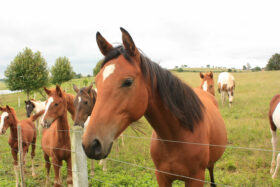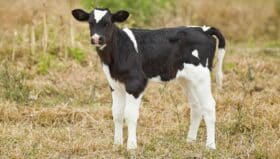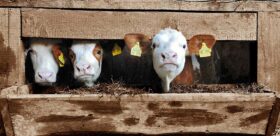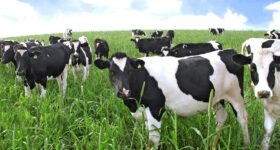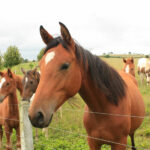Author: Judith Schmidt, Product Manager On-Farm Solutions
The respiratory tract in horses is prone to various problems, ranging from allergic reactions and inflammation to infections. Through early diagnosis, appropriate treatment, and preventive measures, horse owners can help maintain the respiratory health of their horses and promote their well-being and performance.
Respiratory diseases are a constant topic of suffering and irritation among horse owners. According to a study published in 2005, respiratory diseases account for about 40 % of all equine internal diseases recorded worldwide (Thein 2005).
The high-performance organ: the horse’s lung
The respiratory tract of our horses is a high-performance system with a large exchange surface between the inside of the body and the environment. The lungs enable the so-called gas exchange, i.e., the transfer of oxygen from the air into the horse´s bloodstream. Only when this gas exchange functions properly can the horse supply its muscles with sufficient oxygen.
Even at rest, about 50 to 80 liters of air per minute enter the lungs of a 600 kg horse. With increasing load, this value can rise up to 2.000 liters per minute at maximum load. If a horse is healthy, it breathes calmly and slowly and takes eight to sixteen deep breaths per minute.
In order to protect the lungs as best as possible from harmful influences, the entire respiratory tract is equipped with a special mucous membrane. When irritated by pathogens or foreign bodies, for example, this mucous membrane forms more mucous and transports it towards the mouth cavity with the help of the finest cilia. In this way, most harmful particles are usually intercepted quickly, reliably and, above all, effectively and, if necessary, coughed up before they can even reach the alveoli and cause damage there.
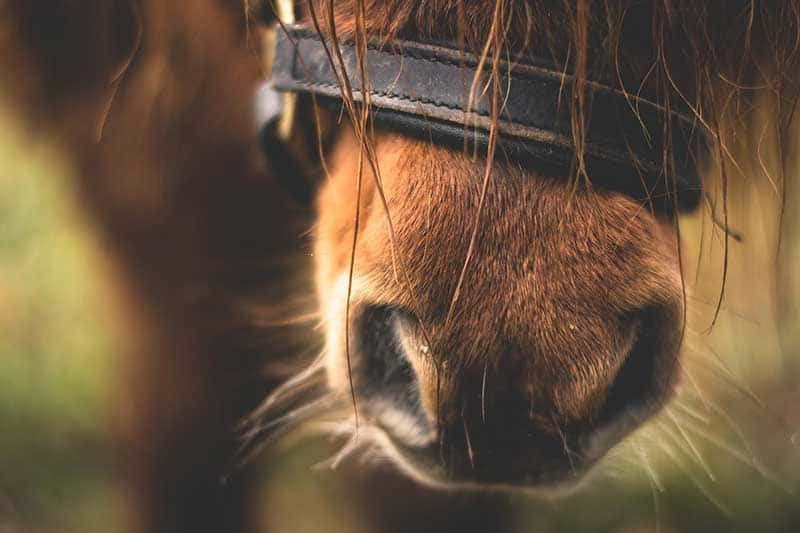
The most common causes of respiratory diseases in horses
Chronic obstructive bronchitis
Chronic obstructive bronchitis is better known as COB or equine asthma. COB is more common in horses that are regularly kept in dusty or poorly ventilated environments, such as cramped stables or pastures with high levels of mold. Inhalation of dust particles and allergens can cause inflammation of the respiratory tract, resulting in coughing, increased mucus expectoration and breathing difficulties. The clinical picture of COB can vary greatly. From occasional poor performance in show horses to chronic coughing with purulent nasal discharge or significant weight loss.
Tracheitis
Another common respiratory disease in horses is tracheitis. This disease is often caused by bacterial or viral infections. Young horses, older horses or those with a weakened immune system are particularly susceptible to tracheitis. Besides infections, irritating factors such as dust, smoke or chemicals can also irritate the mucous membrane of the trachea and trigger inflammation.
Hay fever
Hay fever, also know as allergic respiratory disease or allergic rhinitis, is a common condition that can also affect horses. Like humans, it is an allergic reaction to certain pollens, molds or other environmental allergens that are suspended in the air. Common signs include sneezing, a runny nose and itchy eyes. However, some horses may also suffer from coughing or respiratory symptoms. Hay fever in horses can occur seasonally, depending on the pollen seasons. Depending on the region and season, the symptoms may be more serve during spring, summer or autumn.
Asthma
Asthma in horses, also known as equine asthma or heaves, is a chronic respiratory disease that occurs mainly in horses. It is similar to in many ways to asthma in humans. The main cause of this disease is hypersensitivity of the respiratory tract to dust, allergens or mold spores in the horse´s environment.
Respiratory distress or harmless rattling?
Horse owners know it – the four-legged friends have an impressive range of breathing sounds. But which are harmless, such as the exited trumpeting through the nostrils during a fright? And which ones could be symptoms of a respiratory disease?
Diagnosing respiratory problems in horses can be challenging because symptoms can often be non-specific and/or show signs similar to several diseases.
Snorting: When horses snort, it is a sign of relaxation. There is usually no cause for concern. Quite the opposite.
Snorting at gallop: Many horses snort rhythmically at a gallop. This is also considered harmless. Snorting is particularly common in thoroughbreds.
Coughing, for example when trotting: Occurs so often that it is often perceived as normal. But it is not. Coughing is always an alarm sign and can indicate an allergy, asthma or a viral or bacterial infection.
Whistling when inhaling: To be on the safe side, a veterinarian should be consulted.
Consequences of respiratory disease
Respiratory disease in horses can have significant economic consequences. If a horse suffers from chronic obstructive bronchitis or another respiratory disease, this can lead to various problems:
- Veterinary costs: The diagnosis and treatment of respiratory diseases often require veterinary visits, medication, and possibly further examinations such as x-rays or endoscopy.
- Reduced performance: A horse with respiratory problems may be severely limited in its performance. It may have difficulty breathing, which can have a negative effect on its athletic performance, equestrian work, or other activities.
- Downtime: During the treatment or recovery period, horses may have to take a break or be taken out of training. This may result in loss of income, especially if the horse was intended for competition or showing.
- Decrease in value: A horse with chronic respiratory problems may lose its value as a sport or breeding horse. Selling price might decrease and the demand for such a horse might decrease too.
To minimize economic impact, early diagnosis and treatment is important, as the implementation of appropriate preventive measures to reduce the risk of respiratory disease.
Prevention
Prevention of equine cough is of big importance to reduce the incidence and severity of the disease.
Clean stable environment
Dust is a common trigger of respiratory symptoms in horses. Regular removal of dust, dirt and mold spores from the stable and horse boxes can help to improve air quality and reduce respiratory stress.
Pasture management
When possible, horses should be allowed access to fresh pastures. The natural outdoor environment helps horses breathe cleaner air and inhale fewer harmful particles.
Hay feeding
Choosing high quality, low dust hay can reduce exposure to allergens. Moist soaking of hay before feeding can also help reduce dust levels.
Ventilation in the stable
Good ventilation in stables is essential to avoid stagnant air and dust accumulation. The use of fans or natural ventilation systems can improve air circulation.
Feed management
Feeding high quality feed that is free of mold and allergens can reduce the risk of respiratory problems. It is important to adjust feed rations to the individual needs of each horse.
Supplements
Supplements can play a positive role in the prevention of respiratory problems in horses if they are used selectively and with expert advice.
- Immune system support: Supplements such as vitamins, minerals and antioxidants can strengthen the immune system. A healthy immune system helps the horse to better defend itself against infections and inflammation of the respiratory tract.
- Certain supplements contain ingredients with anti-inflammatory properties, such as omega-3-fatty acids or herbal extracts. These can help reduce inflammation in the respiratory tract and thus reduce the risk of respiratory problems.
- Supporting respiratory health: Some supplements on the market have been specially designed to support respiratory function. They can help to regulate mucus production, improve respiratory protection, and facilitate the expectoration of mucus.
- Strengthening lung capacity: Certain ingredients in supplements can support the horse´s lung capacity and promote better oxygen uptake, which is important for performance and respiratory health.
Conclusion
If there are noticeable breathing sounds, coughing, fever or a drop in performance, the vet should come quickly. A respiratory disease tends to develop into a long-term problem if it is not treated appropriately. Without treatment, it can become chronic in some cases. Fresh air and species-appropriate husbandry, as well as feed that is free of mold und dust, are the first steps to supporting the normal function of your horse´s respiratory tract. Supplements can be an excellent tool for prevention. A holistic approach to equine health is crucial. This includes proper stable and feed hygiene, sufficient exercise, and good air quality in stables.
References:
Handbuch Pferd: Dr. med. vet. Peter Thein, 2005
Tierklink Kaufungen (2016): Chronische Obstruktive Bronchitis (COB), Barbara Liese & Dr. Kristian Sander


